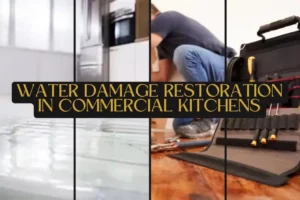Water damage restoration in commercial kitchens presents unique challenges due to the specific nature of these environments. Commercial kitchens are high-activity areas with a constant flow of water, heat, and various equipment. When water damage occurs, it can jeopardize the functionality of the kitchen, compromise food safety, and lead to financial losses.
In this article, we will explore the specific challenges associated with emergency water removal and the importance of a prompt response. For residents and businesses in need of immediate assistance, the keyword “emergency water removal near me” becomes a vital search criterion. Understanding the significance of this service and knowing how to connect with experienced professionals in your local area can make a substantial difference in the efficiency and success of water damage mitigation efforts. Let’s delve into the critical aspects of emergency water removal and the key considerations for finding swift and effective solutions nearby.
Addressing these challenges requires a specialized approach to ensure a swift and effective restoration process.
1. Rapid Response

In commercial kitchens, time is of the essence. Quick response to water damage is crucial to minimizing downtime and preventing further damage. Restoration professionals must be readily available to assess the situation and implement immediate solutions.
2. Specialized Equipment
Commercial kitchens house a variety of specialized equipment, such as industrial-sized ovens, refrigerators, and cooking appliances. Water damage restoration teams need to be equipped with specialized knowledge and tools to assess, repair, and restore these complex systems.
3. Food Safety Concerns
Water damage in a commercial kitchen can compromise the safety of food products. Restoration efforts must prioritize the removal of contaminated items, thorough cleaning and disinfection, and ensuring that the kitchen meets health and safety standards before resuming operations.
4. Structural Integrity
Water damage can affect the structural integrity of the building, especially in areas where heavy equipment is present. Restoration professionals need to assess potential structural damage and take appropriate measures to reinforce and repair affected areas.
5. Electrical Hazards
Commercial kitchens have a high concentration of electrical appliances and systems. Water damage increases the risk of electrical hazards. Restoration teams must exercise caution, ensuring that electrical components are thoroughly inspected, repaired, or replaced to prevent safety risks.
6. Compliance with Regulations

Commercial kitchens are subject to health and safety regulations. Restoration efforts must align with these regulations to ensure that the kitchen meets the required standards before resuming normal operations. This may involve obtaining approvals from health authorities.
7. Comprehensive Drying Techniques
Proper drying is essential to prevent mold growth and secondary damage. However, the presence of intricate equipment and hard-to-reach areas in commercial kitchens requires advanced drying techniques. Restoration professionals must employ methods that ensure thorough drying without causing additional damage.
Conclusion
Navigating these unique challenges in commercial kitchen water damage restoration requires a combination of expertise, experience, and specialized equipment. Businesses in need of such services should seek professional restoration companies with a proven track record in handling water damage specifically in commercial kitchen environments. By addressing the challenges promptly and comprehensively, businesses can minimize disruptions, uphold safety standards, and resume normal operations with confidence.
For businesses in need of reliable water extraction and repair services tailored to the challenges of commercial kitchens, partnering with experienced professionals is crucial. By choosing restoration services that specialize in the unique demands of these environments, businesses can expedite the recovery process, minimize disruptions, and uphold the highest standards of safety and operational efficiency.
